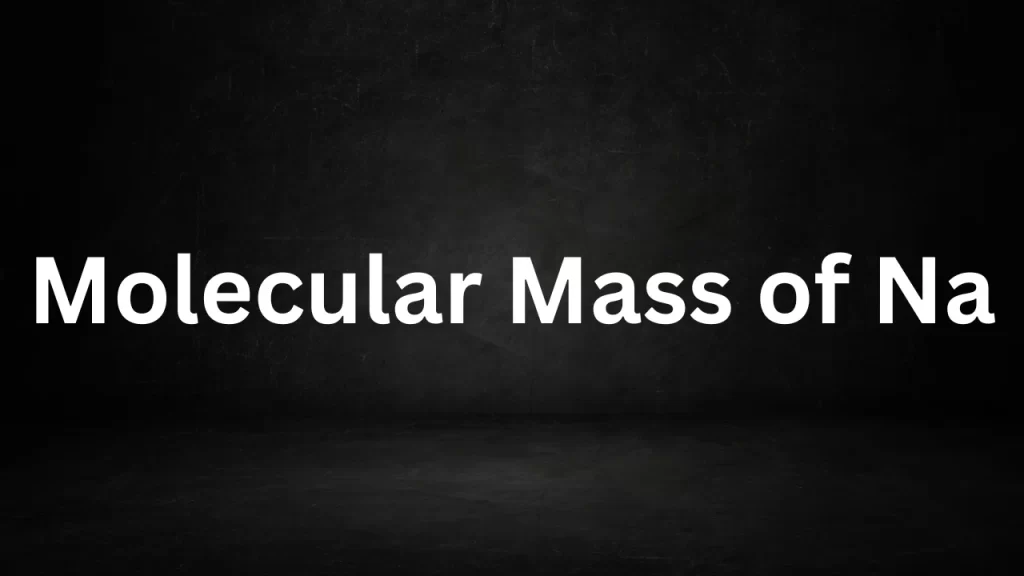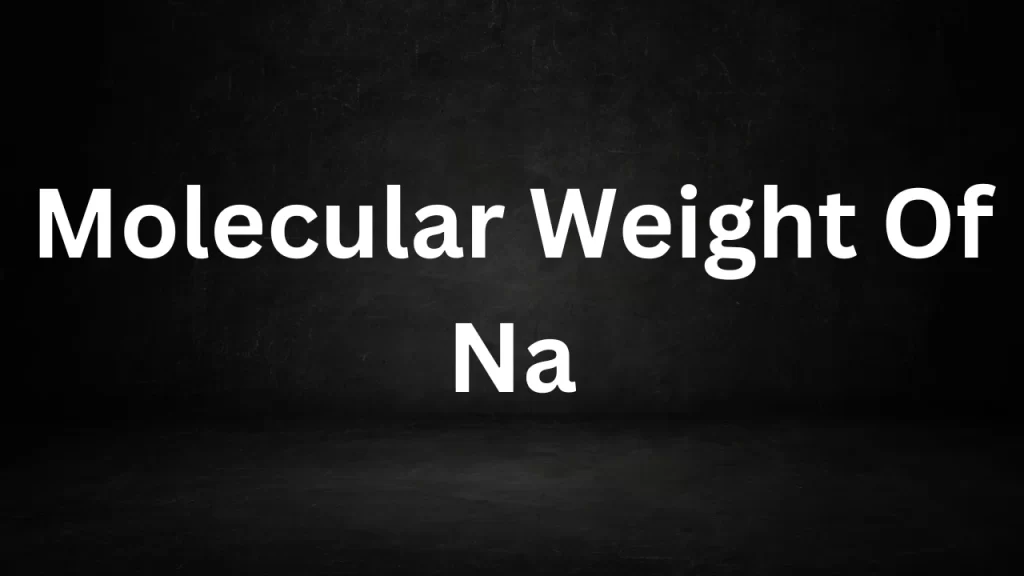Tag: na edta molecular weight
Molecular Mass of Na
Molecular Mass of Na: Sodium, with its symbol “Na” derived from the Latin word “natrium,” is a highly reactive chemical element found in group 1 (or Group IA) of the periodic table.
This metal is well-known for its importance in various biological processes and industrial applications. To understand the properties and utility of sodium, it’s essential to explore its molecular mass, also referred to as atomic weight.
In this article, we will delve into the molecular mass of sodium and its significance in both scientific research and practical applications.

Molecular Mass of Na
The Atomic Structure of Sodium
Before delving into the molecular mass of sodium, it’s crucial to understand its atomic structure. Sodium, with the atomic number 11, contains 11 electrons in various energy levels or shells surrounding its nucleus. Its atomic mass is approximately 22.99 atomic mass units (amu). Sodium has only one stable isotope, sodium-23 (Na-23), which accounts for its average atomic mass.
Molecular Mass vs. Atomic Mass
To avoid confusion, it’s important to differentiate between atomic mass and molecular mass. Atomic mass refers to the mass of a single atom of an element, while molecular mass (or molecular weight) is the mass of a molecule, which consists of two or more atoms. In the case of sodium, it typically exists as individual sodium atoms (Na) rather than diatomic molecules.5
Calculating the Molecular Mass of Sodium (Na)
To determine the molecular mass of sodium, we consider the atomic mass of a single sodium atom:
- The atomic mass of sodium (Na) is approximately 22.99 atomic mass units (amu).
- Since sodium is primarily encountered as single atoms, there is no molecular mass to calculate beyond the atomic mass.
Significance of Molecular Mass in Sodium
While the concept of molecular mass is less applicable to sodium, the atomic mass of sodium is crucial for various reasons:
- Chemical Reactions: Sodium is highly reactive and readily forms compounds with other elements and compounds. Its atomic mass plays a vital role in stoichiometry, helping to determine the amounts of reactants and products in chemical reactions.
- Electrolytes in Biology: Sodium ions (Na+) are essential electrolytes in biological systems, playing a critical role in nerve function, muscle contraction, and maintaining fluid balance in the body.
- Industrial Applications: Sodium and its compounds are used in various industrial processes, including the production of chemicals, metallurgy, and as coolants in nuclear reactors.
- Salt Production: Sodium chloride (table salt) is a ubiquitous seasoning and food preservative, and the atomic mass of sodium is a key factor in determining the salt’s composition and properties.
- Energy Storage: Sodium-ion batteries, a potential alternative to lithium-ion batteries, rely on the chemistry of sodium. The atomic mass of sodium is important for designing efficient energy storage systems.
Conclusion
Sodium, a versatile and reactive element, has an atomic mass of approximately 22.99 atomic mass units (amu). While sodium primarily exists as individual atoms (Na) rather than molecules, its atomic mass is fundamental to its chemical properties and various applications. Understanding the atomic mass of sodium is essential for predicting its behavior in chemical reactions, its roles in biological systems, and its utility in industries ranging from metallurgy to energy storage. Sodium’s significance in both scientific research and practical applications underscores its importance in our modern world.
Read More
- Chemical Properties of Acid
- Molar Mass of Benzene
- Molar Mass of Calcium
- Electromagnetic Spectrum X Rays
- Electric Circuit Electrical Symbols
Frequently Asked Questions (FAQs) Molecular Mass of Na
What is the molecular mass of sodium (Na)?
Sodium, typically encountered as individual sodium atoms (Na), does not have a molecular mass in the traditional sense. Its atomic mass is approximately 22.99 atomic mass units (amu).
What is the difference between atomic mass and molecular mass?
Atomic mass refers to the mass of a single atom of an element, such as a sodium atom (Na). Molecular mass (or molecular weight) refers to the mass of a molecule, which consists of two or more atoms chemically bonded together. Sodium is primarily found as individual atoms, so its molecular mass is not typically calculated.
Why is the atomic mass of sodium important?
The atomic mass of sodium is crucial in various fields, including chemistry and biology. It plays a significant role in stoichiometry, determining the quantities of reactants and products in chemical reactions. In biology, sodium ions (Na+) are essential for various physiological processes.
Is sodium always found as single atoms (Na) in its natural state?
Sodium is a highly reactive metal and is typically found as individual sodium atoms (Na) in its natural state. It readily forms compounds with other elements and molecules due to its reactivity.
What are some common uses of sodium in industry?
Sodium and its compounds have numerous industrial applications. These include metallurgy (sodium is used as a reducing agent), chemical production (sodium compounds are used in the manufacture of various chemicals), and nuclear reactors (sodium is used as a coolant).
Molecular Weight Of Na
Molecular Weight Of Na: Sodium, with the chemical symbol Na and atomic number 11, is an essential element found in the Earth’s crust and oceans.
In this article, we will explore the molecular weight of sodium, its significance in chemistry, and its critical role in various biological and chemical processes.

Molecular Weight Of Na
The Ubiquitous Element: Sodium
Sodium is one of the most abundant elements on Earth, primarily occurring in the form of compounds like sodium chloride (table salt) and various minerals. It is a highly reactive metal that is never found in its pure form in nature due to its extreme reactivity with moisture and oxygen.
Molecular Weight of Sodium (Na)
The molecular weight of an element, often referred to as its atomic weight or molar mass, is defined as the mass of one mole of atoms of that element, measured in grams per mole (g/mol). To calculate the molecular weight of sodium (Na), we use its atomic mass:
- Sodium (Na) has an atomic mass of approximately 22.99 g/mol.
- The molecular weight of sodium is, therefore, approximately 22.99 grams per mole.
Significance of Molecular Weight in Chemistry
The molecular weight of sodium is a fundamental value in chemistry. It is used in stoichiometry, chemical calculations, and the formulation of chemical equations. Chemists rely on molecular weights to determine the quantity of sodium and other elements involved in chemical reactions, allowing for precise measurements and accurate predictions.
Sodium’s Role in Biology and Chemistry
Sodium plays pivotal roles in both biology and chemistry:
1. Biological Significance: Sodium is an essential electrolyte in the human body, critical for various physiological processes. It including nerve function, muscle contraction, and maintaining fluid balance. Sodium ions (Na+) are actively transported in and out of cells, contributing to electrical impulses and the transmission of signals in the nervous system.
2. Chemical Reactivity: Sodium is highly reactive, particularly in the presence of water. It vigorously reacts with water to produce sodium hydroxide (NaOH) and hydrogen gas (H2). This property makes sodium valuable in various chemical processes and industries.
3. Sodium Compounds: Sodium forms compounds with a wide range of elements, such as chlorine (NaCl), forming common table salt. These compounds have diverse applications in food, industry, and medicine.
Conclusion
The molecular weight of sodium (Na), approximately 22.99 g/mol, represents the mass of one mole of sodium atoms. This seemingly simple element is indispensable in the natural world, influencing both biological and chemical processes. Sodium’s importance in maintaining human health, its reactivity in chemical reactions. Its role in various compounds underscore its significance in our daily lives and in the broader fields of chemistry and biology.
Read More
- Molecular Mass Of O2
- Molecular Mass of H2
- Molecular Mass Of NH3
- Molecular Mass Of Ch4
- Nitric Acid Molar Mass
Frequently Asked Questions (FAQs) Molecular Weight Of Na
Q1: What is the molecular weight of sodium (Na)?
A1: The molecular weight of sodium (Na) is approximately 22.99 grams per mole (g/mol).
Q2: Why is the molecular weight of sodium important in chemistry?
A2: The molecular weight of sodium is important because it allows chemists to determine the mass of one mole of sodium atoms. Which is crucial for stoichiometry, chemical calculations, and the formulation of chemical reactions. It helps in understanding the quantity of sodium involved in various chemical processes.
Q3: Is sodium always found in compounds rather than in its pure form in nature?
A3: Yes, sodium is highly reactive with moisture and oxygen, so it is never found in its pure form in nature. Instead, it is typically found in the form of compounds, such as sodium chloride (table salt), sodium carbonate, and various minerals.
Q4: What is the significance of sodium in biology?
A4: Sodium is an essential element in biology, playing a crucial role in nerve function, muscle contraction, and maintaining fluid balance in the human body. Sodium ions (Na+) are involved in transmitting electrical signals in the nervous system.
Q5: How is sodium used in chemistry and industry?
A5: Sodium’s reactivity makes it valuable in various chemical processes and industries. It is used in the production of sodium hydroxide (NaOH), which is a key ingredient in the manufacture of soap, paper, and textiles. Sodium also has applications in metallurgy, organic synthesis, and as a reducing agent in some chemical reactions.